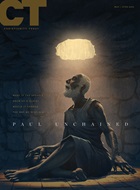I was in eighth grade, Mrs. Pasyanos's English class to be exact, when I stared at the clock and waited for the world to end. That was the year Hal Lindsey had pegged for Christ's Second Coming, and someone else had gone a step further, identifying a date and time. Other than a 5-minute break in a lecture on parts of speech, nothing happened. The hapless prophet probably had some statement for the next day's papers, and everyone moved on.
The rapture scare of 1988 ranks quite low on the all-time list. The year 1000 might top the European charts, though some scholars aver that hardly anyone knew what year it was at the time. Here in America, the Millerite mania of 1843-1844 takes the prize.
In an age with more than its share of raving revivalists, incendiary abolitionists, spooky spiritualists, and self-proclaimed messiahs, William Miller seemed an unlikely striker of panic. He tended a farm in Vermont, fought in the War of 1812, and served as a justice of the peace. His religious life, however, had not been so steady.
Early in life, Miller followed Deism, the rationalistic faith of many American intellectuals (and several founding fathers). He converted to Christianity in 1816, then began assiduous study of the Scriptures. He found the prophecies of Daniel especially compelling and used a few key numbers from the text to calculate the date for Christ's return. The formula went something like this:
- Daniel 8:14 says that after 2,300 days, the sanctuary will be cleansed.
- "Day" actually means "year," and the cleansing of the sanctuary means the eradication of evil on earth—in other words, the End.
- According to James Ussher, an influential Anglican bishop with a passion for dating biblical events, Daniel recorded that prophecy in 457 B.C.
- Add 2,300 years to 457 B.C., and you get 1843.
Miller arrived at this conclusion not long after his conversion, but he didn't tell anyone about it until 1831. Soon invitations to speak began to pour in, and Miller became a local phenomenon. He gained wider audience in 1838 by publishing Evidence from Scripture and History of the Second Coming of Christ, About the Year 1843 and partnering with pastor Joshua V. Himes, who would serve as his publicist. An estimated 50,000 people took the message to heart and prepared to meet their maker, while hundreds of thousands more at least casually turned an eye to the skies.
As the title of Miller's book indicates, he had not pinpointed a date for the apocalypse. Pressed for more specificity, he could only offer the span March 21, 1843 to March 21, 1844—the beginning and end of the Hebrew year. Unfortunately, March 1844 saw no lions lying down with lambs. Miller announced that he must have erred, but one of his followers dipped back into the Scriptures to adjust the calculations. After the "tarrying time" cited in Habakkuk 2:3 and Leviticus 25:9 was factored in, October 22, 1844, got the nod.
.Once again, nothing happened. Or did it?
A small group of Millerites determined that Christ had cleansed the sanctuary on that fateful day, but only in heaven. Earth, they claimed, failed to participate in this glory because the earthly church neglected the true Sabbath (Saturday). This group, led by James and Ellen Gould White, went on to become the Seventh-day Adventist Church.
Pretty much everyone else deemed Miller and his prophecies pure folly. The October debacle became known as the Great Disappointment, and Miller died, lonely and broken, five years later.
In one sense, however, Miller's ideas won the day. Unlike most nineteenth-century American Christians, Miller believed that God's decisive intervention, not Christians' pious actions, would institute the millennial kingdom. Twentieth-century fundamentalists carried on this belief, in contrast to liberals who emphasized human progress and perfectability. Many evangelicals still await the cosmic interruption Millerites anticipated more than 150 years ago, though almost none go so far as to nominate a day or hour.
Copyright © 2002 Christianity Today. Click for reprint information
.
Support Our Work
Subscribe to CT for less than $4.25/month




























